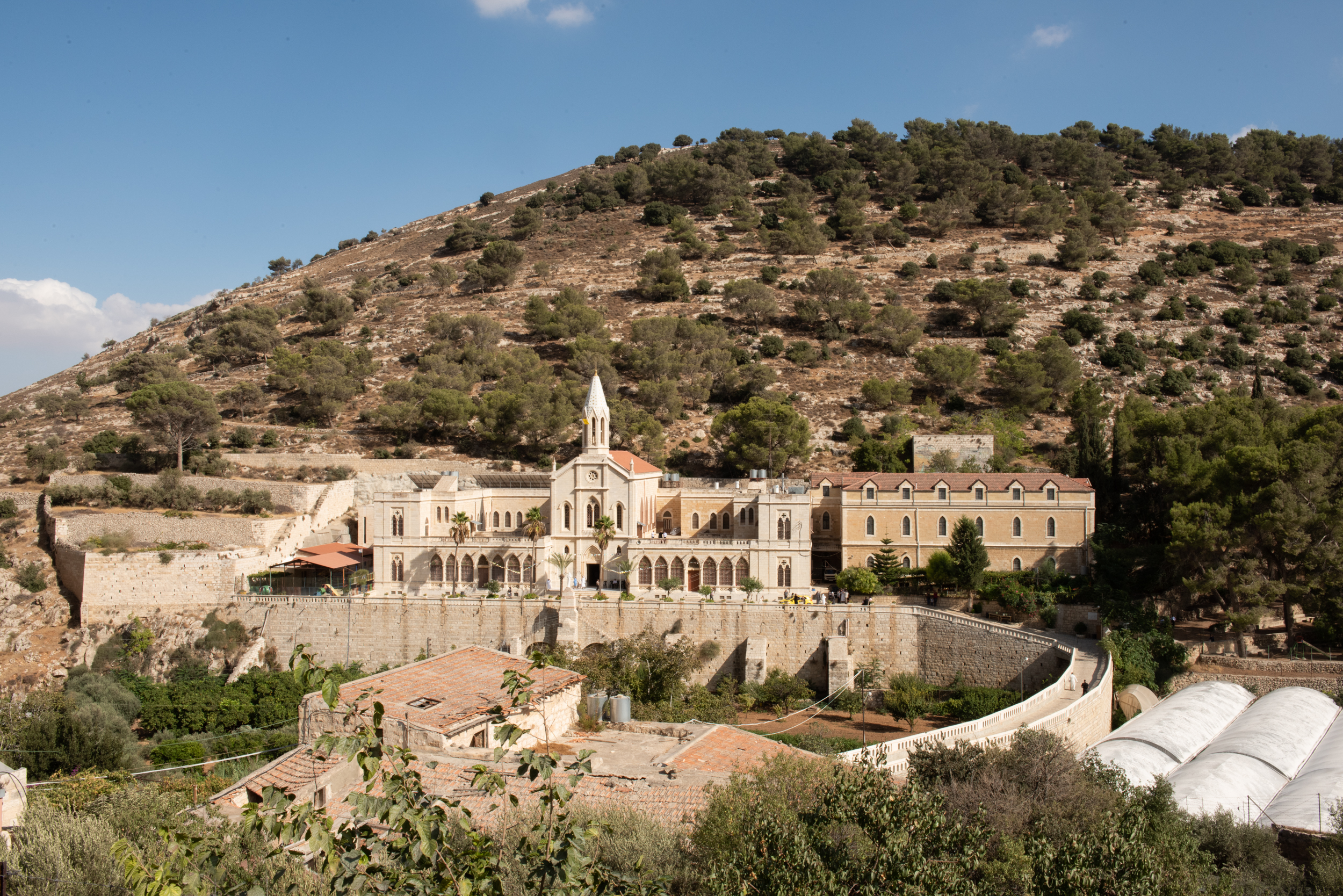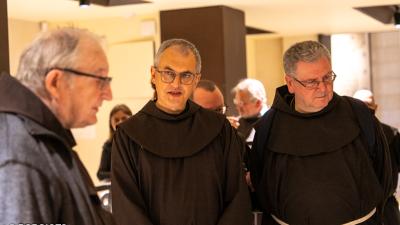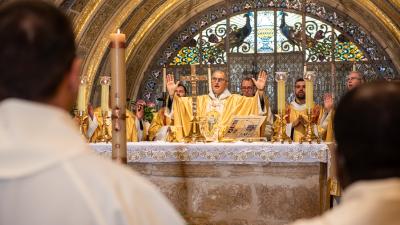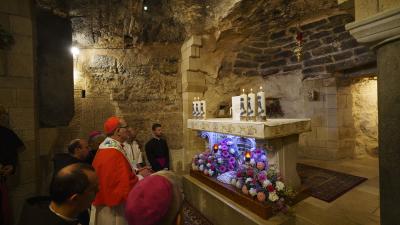
A great celebration at the sanctuary of the Hortus Conclusu, one of the lesser-known shrines of the Holy Land. The presider of the Holy Mass on 9th september was the Custos of the Holy Land, Fr. Francesco Patton
Built on the hill in front of the village of Artas, in the territory of Bethlehem, the verdant land of the sanctuary and its architecture contrast with the dryness of the area. The shrine was the desire of Mons. Mariano Soler, the Archbishop of Montevideo, Uruguay, and rises above the small valley and it leans against the mountain. Because of its fertile land, the location has always been identified as the “closed garden” (hortus, in Latin), which can be read about in Chapter 4, verse 12, of the Song of Songs: “A garden enclosed, my sister, my bride, a garden enclosed, a fountain sealed!” In 1885, the Archbishop, on pilgrimage to the Holy Land, decided to commit himself to building a place intended for the incessant praise of Mary on the basis of that verse of the Song of Songs.
Built over four years, the shrine was entrusted to the Daughters of Mary Most Holy of the Garden as a material sign of the love of Mons. Soler for the Virgin of the Garden and to the Daughters, at whose convent in Uruguay he always used to find refuge and comfort himself through prayer. In 1904, it was then united to the Shrine of the Blessed Virgin of the Garden of Chiavari and, a year later, to the Basilica of Saint Mary Major. For this reason, it enjoys the privileges and indulgences granted to the Basilica.
Given its natural beauty, the Hortus has been used for several years as a retreat house for groups, movements and fraternities. Many people, including young men who are undergoing formation with the Friars Minor of the Custody of the Holy Land, come to this oasis for spiritual retreats.
Currently, the Superior of the House is Sister Rosa de Toro, from Argentina, who has lived in the Hortus since 2005. Having always worked on the formation of novices and postulants in the religious province of Cordoba, she carried out her service there until 2005.
How did you find the Order?
I received a Catholic education and in my youth, I started to lead the children of the catechism and with them I too began to pray and fall in love with Jesus. I was looking for a congregation that did not require a single apostolate because I had understood that my mission had to be to make myself fully available so that I could do all kinds of apostolates. The only thing that interested me was to following Jesus wherever he wanted me to go. A priest directed me to them and I approached them: I entered the novitiate in 1987. I was 20 and I am now 52. In my religious life I have never regretted having been “caught” by Jesus in this way .
What is the charism of your institute?
Our name is clear: Sisters of Charity, Daughters of Mary Most Holy of the Garden. Our founding charism is "watchful evangelical charity.” The Order was started in 1829 because at that time there were no consecrated religious women in Chiavari and the only religious presence was that of the Sisters of St. Vincent, who were contemplative. So, our institute was founded by responding to the need to “go where others could not go,” in a physical sense, and to “respond to all kinds of needs without having a specific type of apostolate, unless it is impossible or inappropriate.”
Where do the pilgrims who visit the Sanctuary come from?
Artas is a completely Muslim village, but our sanctuary is very popular. The faithful come from all over Israel and Palestine, from Beit Shour, to Beit Jala, Bethlehem, to Jerusalem, to Galilee. During the year many come to visit the Virgin Mary, including several faithful of the Greek-Orthodox rite.
Why do you think having the Sanctuary in this place is beneficial?
I’m often asked about reason for our presence here in this land. They ask me, “What are you doing there if you are not converting anyone? They are all Muslim.” We have not come here to convert anyone: we are here to protect this part of the Holy Land that keeps the image of the Madonna prefigured in the Song of Songs alive. I believe this is a super prophetic presence because everyone here feels at home: Franciscans, the Latin Patriarchate, Muslims, Jews, Armenians, Syriacs, Greek Orthodox. Here everyone feels like children united by Our Lady.
The desserts that we handed out on the day of the feast of Our Lady, which was celebrated on Sunday, September 9, as well as the flowers for the decorations were handled not by the nuns but by the Greek Orthodox people. We do not ask for donations but Providence comes through because people love the Virgin Mary.
What activities have you carried out over the years?
Right now, we provide a service that not all of the welcome centers offer: we are a retreat house. We offer the facilities and conditions necessary for any group that comes here to feel right at home. We close the doors of the sanctuary to ensure that the environment is appropriate. We do not offer luxury; we do not even have air conditioning, but people seek silence and peace, not comfort. We need to keep ourselves in prayer and look for God. I think the greatest service we can offer is this: not allowing Christians to forget about God, who loves them.
In addition to this, we had operated an outpatient clinic since 1901. It has been shut down for two years because it is currently impractical due to poor maintenance on the land located in front of it. Since the founding of the Sanctuary, there was an orphanage connected to the school that welcomed Christian orphan girls and also housed children who lived too far away so as to encourage them to attend. Observing the way the nuns educated these girls, the Muslim parents of Artas asked the nuns to open a kindergarten so that they could enroll their children too. So, in 1974 we opened the nursery school which currently has 50 Muslim children, who are 4 and 5 years old.
What does it mean for you to live in this place?
First of all, for the Congregation this sanctuary is a gem, it is really something precious. This is the sanctuary directly connected to the Virgin Mary of the Garden in Chiavari, the place that is referred to and described in the Song of Songs.
For me, it is like living at the source from which we drink our Marian and biblical spirituality. Our poverty that makes us capable of “going where others cannot go” comes from the grotto of Bethlehem. So, it is all here: the Song of Songs and Christmas. This place is the center of my whole life.
Giovanni Malaspina




